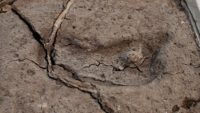By Ken Ham Researchers in the South American nation of Chile have announced the discovery of a human footprint they’ve dated at 15,600 years. This makes it the oldest evidence of humans in the Americas by over 3,000 years, according to the evolutionary timeline. How should Christians understand finds such as these? Well, first we compare what the study says against the absolute authority of the Word of God. Starting with God’s Word (using the six days of creation and the genealogies), we know the earth is only around 6,000 years old, and the world was destroyed at the time [More]
By Ken Ham Scripture tells us God’s original creation was “very good” (Genesis 1:31), so why do we see so many creatures with toxins, venoms, and poisons seemingly designed to harm and kill? Get answers to that question, and many more, in the latest issue of our Lethal lizards is the cover story for this latest issue, but you’ll also discover three ways evolution violates basic science, the design of fennec foxes, and why the water in your lungs is actually a good thing and part of God’s marvellous design. You’ll also find articles such as: The La Brea Tar [More]
By Harry F. Sanders, III A study looked at the colors of lice on the feathers of numerous varieties of pigeons. According to the authors, the research was proof of evolution. Is it so? …read more Source: AIG Daily
How did their digestive biology change to make them need meat? …read more Source: creation.com
By Ken Ham Last summer, we introduced our unique Explore Science 5-Day Summer Camp at the Creation Museum. It was very popular among the children who participated in it. They gave us great feedback such as “Best camp I’ve been too!” and “I met new friends and learned loads of science.” This year, we’re offering two Explore Science day camps and a new offering—Explore Forensics 3-Day Camp. Your child won’t want to miss out! Each camp teaches hands-on science from a biblical perspective. Campers will learn from top experts and enjoy all the Creation Museum has to offer as they [More]
By Sarah Chaffee On this episode of ID the Future from the vault, Sarah Chaffee interviews CSC Senior Fellow Ann Gauger about apoptosis – or self-induced cell death – and how it plays into multicellular life. Listen in to learn more about the immune system, development, and how apoptosis demonstrates purpose. Your browser does not support playing Audio, please upgrade your browser or find our podcast on podOmatic Download Episode …read more Source: id the future
Paleontologists just discovered a fossil of a new type of extinct ferocious-looking mammal that’s bigger than any lion or tiger living today.1 This bizarre creature highlights the amazing diversity of lost mammal species that were preserved as fossils in sedimentary rocks deposited during Noah’s Flood. Discoveries like this continue to debunk the evolutionary myth of “simple to complex” that we should find… More… …read more Source: icr.org
We ought to care about creation, for God himself made it and cares about it. The rhino is a magnificent creature who exhibits our Creator’s handiwork. …read more Source: AIG Daily
By Dr. Carrie John The viceroy is a colorful butterfly that is known to mimic other species. But it is not just a tasty option that looks like the unpalatable models it mimics. …read more Source: AIG Daily
By Harry F. Sanders, III The clownfish is clearly designed for the environment in which it lives while providing some startling challenges to the standard evolutionary model. …read more Source: AIG Daily
By Ken Ham We’re gearing up to announce our 2020 Answers VBS theme—and we’re giving away five Super Starter VBS kits and other prizes (valued at hundreds of dollars) along the way! This is an exciting opportunity for your church to win everything they need to get started with next year’s VBS. Starting today and ending June 3 at 8:59 a.m., EDT, we will be sending weekly clues to contest participants to help them guess what our 2020 theme will be. And we’ll also be giving away one prize each week as we wait for the exciting announcement. These prizes [More]
How can you help friends recognize the solid science that confirms creation? What discoveries from biological research support the Bible? How will the ICR Discovery Center showcase geological research? And how does biblical creation help us glorify God? Discover the answers to these questions and more in the May 2019 issue of Acts & Facts! &n… More… …read more Source: icr.org
The results of a computer analysis to investigate how the solar system might have formed should cause evolutionists to think again about naturalistic processes. …read more Source: creation.com
What has Easter got to do with the creation of the world and humanity? Well, consider that the resurrected Jesus taught from the authority of Moses’ books (which include Genesis)! …read more Source: creation.com
By Brian Thomas and Jeffrey Tomkins The story of whale evolution is one of the most ridiculous fables of scientifically unsupported speculation ever perpetrated on the public. And now, with the recent discovery of a Peruvian fossil of a clearly four-legged land animal named Peregocetus being called “An Amphibious Whale,” the evolutionary myth has just di… More… …read more Source: icr.org
By Ken Ham A study from the Barna Group revealed that half of US pastors “feel worried about speaking out on certain issues because they’re worried about offending people,” particularly people in their own churches. Predictably, LGBT issues and gay “marriage” concern them most, with abortion and sexual immorality as runners-up. Interestingly, pastors seem to recognize that they should be influencing their congregations on these issues: “More than nine in 10 Pastors . . . believe they have influence with their congregants when it comes to how they think about current issues in society.” “9 out of 10 Christian pastors [More]
By Dr. David Menton The secret ingredient to continual breathing? Water. …read more Source: AIG Daily
By Ken Ham Last week we had a tremendous Easter conference entitled Answering Atheists, at the Ark Encounter in our brand-new 2500-seat Answers Center. Hundreds of individuals and families came from across the United States and even other countries to Williamstown, Kentucky, to learn how to reach atheists with the gospel of Jesus Christ. During the conference, we also had a special dedication ceremony for the Answers Center. During this ceremony, the three founders of AiG (Mark Looy, …read more Source: Ken Ham AIG
By Michael J. Behe On this episode of ID the Future, Andrew McDiarmid continues his series with Michael Behe about Behe’s new book Darwin Devolves: The New Science about DNA That Challenges Evolution. Here Behe explains the “Revenge of the Principle of Comparative Difficulty,” According to this principle, evolution it is much easier for evolution to create a new adaptive niche by damaging one or more genes than even the simplest new genes and irreducibly complex structures. Along the way, Behe also explores how biology got enamored of mathematical theory built on “hopeful ignorance” regarding the nature of genes. Please [More]
How can we begin correlating the Bible’s chronology with data outside the Bible? …read more Source: creation.com
By Ken Ham I love being able to tell our supporters about other ministries that hold to the truth and authority of God’s Word and are working hard to equip the next generation to know and love it. And that’s why I’m excited to promote the Bible memorization not only helps them hide God’s Word in their hearts but also assists in learning how to properly read and study Scripture. When many people think of the National Bible Bee, they think of the National Bible Bee Competition where hundreds of young people compete each year for the opportunity to win [More]
By John C. P. Smith There is a considerable disconnection between lexicography regarding ???? and the formation of creation theology. …read more Source: AIG Daily
Have they now finally found a whale missing link, Peregocetus pacificus? …read more Source: creation.com
The story behind an engineer who left the mining industry and fulfilled a desire to preach. …read more Source: creation.com
By Sarah Chaffee On this episode of ID the Future from the vault, Ann Gauger shares about the cell as a bustling city. What is the powerplant of the cell? How about its thoroughfares? Waste recycling? Listen in to learn more! Your browser does not support playing Audio, please upgrade your browser or find our podcast on podOmatic Download Episode …read more Source: id the future
On April 10, 2019, a team of astronomers revealed the first-ever photograph of a black hole.1 Modern physics sees time and space as being interconnected, forming a kind of “fabric” or “membrane” called spacetime. A black hole is a region of spacetime that is extremely distorted by the presence of a sufficiently dense mass. The gravity in this region is so strong that anything getting too close to … More… …read more Source: icr.org










































